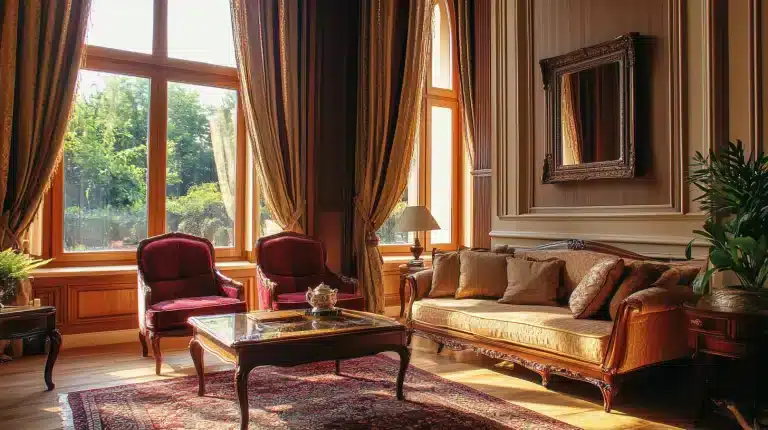Crafting a home that seamlessly blends aesthetics and functionality is a challenge many homeowners face. It requires thoughtful planning to ensure that both beauty and practicality are given equal consideration.
So, the questions of how to achieve this delicate balance often arise.
In this post, we will explore essential tips and strategies to help you create a harmonious living space that reflects your personal style while also catering to your everyday needs.
What Does It Mean to Balance Aesthetics and Functionality?
Aesthetics and functionality are two fundamental aspects of home design that, when combined effectively, can lead to a harmonious living environment. Aesthetics refers to the visual appeal of your space — colors, textures, shapes, and overall style. Functionality, on the other hand, pertains to how well the space serves its intended purpose — comfort, accessibility, and practicality.
Aesthetics in home design includes elements such as:
- Color palette and schemes
- Textures and patterns
- Architectural features
- Furniture styles and arrangements
- Lighting design
- Decorative accessories
Functionality, on the other hand, focuses on how well a space serves its intended purpose. It involves:
- Efficient space planning and layout
- Ergonomic design principles
- Storage solutions
- Traffic flow and circulation
- Adaptability to changing needs
- Ease of maintenance and cleaning
Together, aesthetics and functionality create a living space that is not only visually pleasing but also comfortable and practical for daily life.
A high-end interior design firm such as White Webb can help homeowners achieve this balance by offering tailored solutions that consider both elements in every design decision.
How To Achieve a Harmonious Home Design That Combines The Two?
Begin your design process by thoroughly analyzing your lifestyle and routines. Consider the following:
- How many people live in your home?
- What are your work schedules and habits?
- Do you entertain frequently?
- Are there any specific hobbies or activities that need dedicated space?
- Do you have pets or children with special requirements?
By answering these questions, you can tailor each room to support specific activities while maintaining an overall aesthetic appeal.
Now, let’s get to some actionable tips to help you achieve a harmonious blend of aesthetics and functionality in your home design:
Tip #1 – Maximize Space with Smart Layouts and Storage Solutions:
Efficient space utilization is key to balancing form and function.
Consider these strategies:
- Implement an open floor plan to create a sense of spaciousness
- Use multi-functional furniture like ottoman storage or murphy beds
- Install built-in shelving and cabinets to reduce clutter
- Utilize vertical space with tall bookcases or hanging organizers
- Incorporate hidden storage solutions in unexpected places (e.g., under-stair drawers)
These design choices maintain a clean, uncluttered aesthetic while ensuring ample storage and functionality.
Tip #2 – Choose Stylish and Functional
Selecting furniture that serves both aesthetic and practical purposes is crucial.
Consider these tips:
- Opt for pieces with clean lines and timeless designs for longevity
- Choose upholstery fabrics that are both attractive and durable
- Look for modular furniture that can be rearranged as needs change
- Invest in quality pieces that will withstand daily use
- Consider the scale of furniture in relation to your room size
For example, a sleek sectional sofa can provide ample seating while maintaining a modern aesthetic. Similarly, an expandable dining table can accommodate both everyday meals and larger gatherings without compromising style.
Tip #3 – Use Lighting that Enhances Both Function and Beauty
Effective lighting design is essential for both aesthetics and functionality. Implement a layered lighting approach:
- Ambient lighting: Use ceiling fixtures or recessed lights to provide overall illumination.
- Task lighting: Incorporate desk lamps, under-cabinet lights, or reading lamps for specific activities.
- Accent lighting: Highlight artwork, architectural features, or decorative objects with spotlights or wall sconces.
Consider using smart lighting systems that allow you to adjust brightness and color temperature to suit different moods and activities throughout the day.
Tip #4 – Leverage Smart Technology to Support Functionality
Integrate smart home technology seamlessly into your design:
- Use voice-controlled smart speakers that blend with your decor
- Install smart thermostats with customizable faceplates to match your wall color
- Opt for motorized window treatments that can be controlled via smartphone
- Choose smart appliances with sleek designs that enhance your kitchen’s aesthetic
- Implement hidden charging stations in drawers or furniture to reduce cord clutter.
Tip #5 – Invest In Sustainable Materials
Incorporate eco-friendly materials that offer both style and practicality:
- Use bamboo flooring for durability and a modern look
- Install energy-efficient windows with stylish frames
- Choose recycled glass countertops for a unique, eco-conscious design
- Opt for low-VOC paints in on-trend colors for healthier air quality
- Use reclaimed wood for statement furniture pieces or accent walls.
Tip #6 – Adapt Spaces for New Functions
Create flexible spaces that can evolve with your changing needs:
- Use modular furniture systems that can be reconfigured easily
- Install sliding doors or movable partitions to divide spaces as needed
- Choose neutral base colors that can accommodate changing decor styles
- Invest in multi-purpose rooms (e.g., guest room/home office combination)
- Regularly reassess your space usage and make adjustments accordingly.
Tip #7 – Try To Create A Timeless Design
Opt for design elements that stand the test of time:
- Choose classic architectural features like crown molding or wainscoting
- Invest in high-quality, timeless furniture pieces as the foundation of your design
- Use trendy elements in easily changeable items like throw pillows or artwork
- Stick to a neutral color palette for major elements, adding pops of color with accessories
- Focus on good craftsmanship and materials that age well.
Balancing Aesthetics and Functionality in Different Spaces
Now that we have discussed general tips for achieving a harmonious home design, let’s explore how to apply these principles in specific areas of your home:
Kitchen: The Heart of Functionality and Style
In the kitchen, focus on creating an efficient workflow while maintaining visual appeal:
- Implement the kitchen work triangle (sink, stove, refrigerator) for optimal functionality
- Choose durable, easy-to-clean materials that also look stylish (e.g., quartz countertops)
- Install pull-out organizers in cabinets to maximize storage while keeping counters clutter-free
- Use a cohesive color scheme for appliances, cabinetry, and backsplash
- Incorporate a kitchen island with seating for both food preparation and casual dining
Living Room: Creating a Comfortable and Stylish Gathering Space
Design your living room to encourage relaxation and social interaction:
- Arrange furniture to create conversation areas
- Use area rugs to define spaces and add warmth
- Incorporate versatile seating options (e.g., ottomans that can serve as extra seating or tables)
- Install built-in entertainment centers to house media equipment without cluttering the space
- Choose a color palette that promotes relaxation while reflecting your personal style
Bedroom: Aesthetic Comfort Meets Practical Design
Create a serene bedroom that promotes rest while meeting storage needs:
- Select a calming color scheme with soothing textures
- Invest in a high-quality mattress and bedding for comfort and style
- Use bedside tables with drawers for hidden storage
- Install a combination of ambient and task lighting for different activities
- Incorporate a small seating area if space allows for a private retreat
Garden: Beauty and Usability in Outdoor
- Extend your living space outdoors with a functional and attractive design:
- Create distinct zones for dining, lounging, and gardening
- Use weather-resistant materials that complement your home’s exterior
- Incorporate built-in seating with hidden storage for outdoor equipment
- Install proper lighting for evening use and ambiance
- Choose low-maintenance plants that add visual interest year-round
Common Mistakes to Avoid When Balancing Aesthetics and Functionality
Avoid these pitfalls when prioritizing aesthetics:
- Choosing impractical materials (e.g., white carpets in high-traffic areas)
- Overcrowding spaces with decorative items that impede movement
- Selecting furniture based solely on looks without considering comfort
- Neglecting storage needs in favor of a minimalist aesthetic
- Ignoring the importance of proper lighting for daily tasks
- Using only utilitarian furniture without considering style
- Neglecting color and texture in favor of easy-to-clean surfaces
- Overusing fluorescent lighting for efficiency without considering the ambiance
- Focusing on storage at the expense of creating inviting living spaces
- Ignoring the importance of decorative elements in creating a welcoming atmosphere
Key Takeaway
Creating a harmonious home that balances aesthetics and functionality requires thoughtful planning and intentional design choices. By considering both the visual appeal and practical aspects of each space, you can craft a home that is not only beautiful but also supports your daily life efficiently.
Remember that achieving this balance is an ongoing process – be prepared to adapt and evolve your space as your needs change over time.
With careful consideration and creativity, you can create a living environment that is both visually stunning and highly functional, enhancing your quality of life and making your house truly feel like home.









